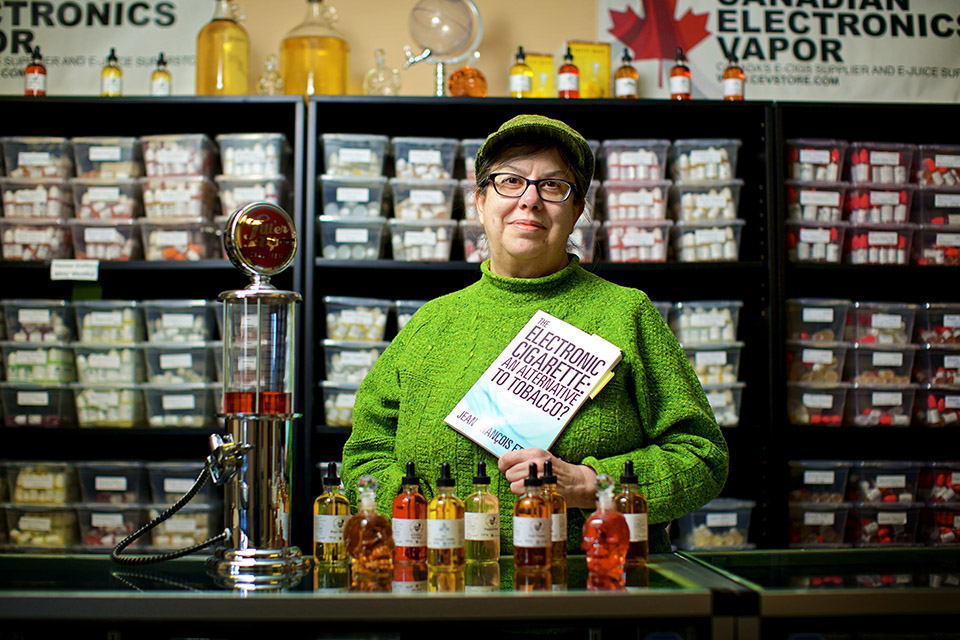Clearing the air
- Suzanne Ahearne

When Renee O’Leary, a PhD student in the Social Dimensions of Health, started casting about for a thesis topic, her first research question was a heavy one: what’s the single biggest public health threat in the world? The answer: tobacco smoking. The then-60-year-old wanted her work to have maximum impact, so she began her research.
In 2013, Tim Stockwell, director of UVic’s Centre for Addictions Research of BC (CARBC) and O'Leary's supervisor, suggested she look into e-cigarettes. Invented in 2003 by a Chinese pharmacist as a smoking cessation device for himself, e-cigarettes didn’t hit the export market until 2006. By the time O’Leary started her research, global sales had already exceeded US $4 billion, with no more than a few dozen scholarly studies written about the harms and benefits of vaping over tobacco smoking. O’Leary saw a huge a gap, switched gears and started focusing on e-cigarettes.
Since then, the number of studies and reports has grown exponentially. So has the controversy around what the evidence shows.
In 2014, her co-supervisor, nursing professor Marjorie MacDonald, received a CIHR grant to examine the evidence around e-cigarettes. Ever since, says O’Leary, she read everything she could on the subject. “And I do mean everything. Not just the research, but the opinion articles and debates in the literature.”
Fears that “vaping” is a gateway to tobacco smoking are unfounded, shows the researchers’ resulting comprehensive review of available evidence on the harms and benefits of electronic or e-cigarettes and vapour devices—released in January by CARBC in a report called “Clearing the Air.”
The researchers surveyed the rapidly increasing academic literature on e-cigarettes and found evidence that vaping is replacing—rather than encouraging—the smoking of tobacco cigarettes among young people. The CARBC researchers identified 1,622 articles on the topic, of which 170 were relevant to their review. Evidence shows that tobacco use by youth has been declining while use of vapour devices has been increasing.
“Fears of a gateway effect are unjustified and overblown,” says principal investigator Marjorie MacDonald. “From a public health perspective, it’s positive to see youth moving towards a less harmful substitute to tobacco smoking.”
Among their other observations, CARBC researchers found strong evidence that the vapour from e-cigarettes is less toxic than tobacco smoke. Vapour devices do not release tar, and vapour emissions contain only eighteen of the 79 toxins found in cigarette smoke. Almost all substances tested were substantially lower, or not detected, in vapour devices compared to cigarettes.
In addition, vapour from electronic devices is airborne for less than 30 seconds compared to 18 to 20 minutes for tobacco smoke, substantially reducing the time of second-hand exposure.
Researchers caution, however, that some vapour devices may contain potentially concerning levels of metals and particulate matter, noting that there has been insufficient research regarding some significant carcinogens that may still be present.
Finally, they found encouraging evidence that vapour devices could be at least as effective as other nicotine replacements as aids to help tobacco smokers quit.
“Many people think they are as dangerous as smoking tobacco but the evidence shows this is completely false,” concludes Stockwell, co-principal investigator.
The team, including Dan Reist, CARBC assistant director, recommends that Canadian regulations of vapour devices be informed by the best available evidence and with a view to improving public health; that more accurate information about their risks in comparison with tobacco use is provided to the public; and that strategies are developed to help people who wish to quit smoking have affordable access to the safest forms of vapour devices.
“As happy as I am to see the harm reduction potential of vapour devices, it’s not the whole solution,” notes O’Leary, adding there are now hundreds of different devices on the market and global sales now exceed $8 billion US.
“That’s great,” she says, “but we’ve got to get combustible tobacco out of the commodity chain, out of the reach of kids and adults. So until we can get cigarettes off the table entirely, this helps and it’s a harm reduction methodology—but it’s not the full tobacco end game. And that’s what I want to see.”

